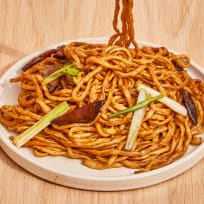Auspicious Longevity Noodles Recipe (Yi Mein / 伊面)
Eric GinsburgCelebrating a special occasion? Dig into Kat Lieu's Auspicious Longevity Noodles Recipe (Yi Mein).
Typically made for Lunar New Year, Auspicious Longevity Noodles (or Yi Mein / 伊面), were also a staple for birthday celebrations in Kat Lieu's family. We're grateful she's sharing her Auspicious Longevity Noodles recipe with us here, which comes from her new cookbook, Modern Asian Kitchen.
Lieu's maternal grandparents would make yi mein to celebrate birthdays and Lunar New Year, varying their preparations and accompaniments, she explains.
"Sometimes, they would keep it simple with just shiitake mushrooms and scallions, while on other occasions, they would feel lavish and add lobster or crabmeat," she writes in Modern Asian Kitchen: Essential and Easy Recipes for Ramen, Dumplings, Dim Sum, Stir-Fries, Rice Bowls, Pho, Bibimbaps, and More.
Lieu is also the author of the best-selling Modern Asian Baking at Home, and the creator of the popular community Subtle Asian Baking. This recipe from her new cookbook can be enjoyed year-round but traditionally would be tied to special occasions. Let's get into the details!
What Are Longevity Noodles, or Yi Mein?
Known by several names including e-fu noodles, yi mein are Cantonese wheat and egg noodles that are deep fried and known for their chewy texture.
"Flat and absorbent, these noodles are excellent carriers for any sauce, like the rich essence of lobster," Lieu writes in the recipe head note of her book. "While I enjoy making yi mein noodles from scratch, I honestly recommend purchasing them premade from an Asian supermarket."
Why is that?
"Homemade yi mein can be fragile and labor-intensive, though using a pasta machine is quite helpful," she explains. "Longevity noodles also need to be deep-fried and then boiled, so when pressed for time, it’s best to opt for store-bought yi mein. Stock up on packs of these versatile noodles, as they are quicker to prepare than dry pasta."
The long, unbroken noodles symbolize longevity — hence the name! — so be careful not to break them while cooking.
Tip: Love this recipe? You should also try Kat Lieu's Heady Chinese Peanut Butter Cookies (Hua Sheng Bing) from the same cookbook!
Tips for Maximizing This Recipe
A couple things that will help you achieve the best possible results!
- Keep in mind that it takes a few hours for dried shiitake mushrooms to rehydrate in water, so plan accordingly. It's easy to do, but just requires advance prep work.
- Although this dish is typically vegetarian, you can customize it by adding proteins like stir-fried lobster, pork, tofu, or abalone.
- Be sure to fully cook the proteins (added along with the shiitake mushrooms) before incorporating the noodles into the wok or frying pan.
- This recipe calls for Shaoxing cooking wine and dark soy sauce. If you don't have both on hand already — they're super common if you're making other Chinese dishes — you can find them at Amazon, Walmart, and other major retailers in the United States.
- To make this dish spicier, you can add a drizzle of Fire Chili Crisp Oil — the recipe is in Modern Asian Kitchen. Alternately, use "a whopping dollop of XO sauce." There are a range of commercially available chili crisp oils, too.
- Serve immediately, because these noodles are best when hot!
Tools You'll Need
This list of things to have on hand is short and simple!
- Small mixing bowl (for the sauce)
- Pot for boiling the noodles
- A strainer
- Wok for cooking
- Stirring utensils
If you watch videos of people cooking yi mein online, you'll often see them using chopsticks to stir the store-bought noodles. This gentle approach helps separate them without breaking any. You'll also need to stir the stir fry in the wok.
Metric System Ingredient Measurements
Prefer to prep using gram and ml measurements? Lieu has you covered.
For the sauce:
- 30 ml soy sauce
- 14 ml dark soy sauce
- 15 ml vegan or regular oyster sauce
- 15 ml sesame oil
- 15 Shaoxing wine
- 13 g brown sugar
Other ingredients:
- 45 ml neutral oil (like canola or avocado)
- 230-340 g yi mein noodles (dry)
- 1 cm ginger
- Cut scallions into 7- to 10-cm segments
Our thanks to Kat Lieu for letting Food Fanatic share this recipe, which originally appeared in her 2024 cookbook Modern Asian Kitchen, published by Harvard Common Press!
Auspicious Longevity Noodles Recipe (Yi Mein / 伊面)
Ingredients
Sauce:- 2 tablespoons Soy Sauce
- 1 tablespoon Dark Soy Sauce
- 1 tablespoon Oyster Sauce, or vegan oyster sauce
- 1 small pinch White Pepper
- 1 tablespoon Sesame Oil
- 1 tablespoon Shaoxing wine
- 1 tablespoon Brown Sugar
- 3 tablespoons Canola Oil, or avocado oil
- 8-12 ounces Yi Mein Noodles, dry
- 6 cloves Garlics, chopped
- 8-10 Shiitake Mushrooms, rehydrated, stems removed and sliced
- 5 Sliced Scallions, cut into 3- to 4-inch segments
- as desired Protein, optional — lobster, pork, tofu, or abalone, cooked and chopped
Directions
- Prepare the sauce by mixing all the sauce ingredients in a small bowl, and set aside.
- Cook the noodles by boiling the dry yi mein noodles for 1 to 2 minutes until they are cooked but still al dente and chewy. These noodles can be fragile, so avoid overcooking them, as you want them to remain long and intact to symbolize longevity. Strain the noodles.
- Preheat a wok or frying pan over medium-high heat until it begins to smoke. Then, add the neutral oil. Add the ginger and garlic, and once the garlic turns golden, add the mushrooms and optional proteins, if desired. Remember to continuously stir the ingredients at high heat while stir-frying.
- After the mushrooms develop a golden-brown coating (and your optional proteins are cooked through), add the noodles and stir. Once they are warm and coated with oil, pour in the sauce. Be gentle when stirring the noodles, as they may break.
- Lastly, incorporate the scallions or chives and cook for about 20 to 30 more seconds before removing the dish from the heat.
- Serve immediately, as these noodles taste best when piping hot. If you enjoy a bit of a kick, a drizzle of Fire Chili Crisp Oil (recipe available in Modern Asian Kitchen!) or a whopping dollop of XO sauce is the perfect finishing touch.
Our thanks to Kat Lieu for letting Food Fanatic share this recipe, which originally appeared in her 2024 cookbook Modern Asian Kitchen, published by Harvard Common Press.
Notes
From author Kat Lieu: "Keep in mind that it takes a few hours for dried shiitake mushrooms to rehydrate in water, so plan accordingly. Although this dish is typically vegetarian, you can customize it by adding proteins like stir-fried lobster, pork, tofu, or abalone. Be sure to fully cook the proteins (added along with the shiitake mushrooms) before incorporating the noodles into the wok or frying pan."
- Published:
- Modified:
- Source:
- Kat Lieu
- Cuisine:
- Asian
- Category:
- Lunar New Year
- Tags:
- Asian, Lunar New Year, Noodles, Chinese, Cookbooks
- Related Recipes:
- Asian Recipes, Lunar New Year Recipes, Noodle Recipes, Chinese Recipes, Cookbook Recipes
- Recipe Yields:
- 4 Servings
- Prep Time:
- Cook Time:
- Total Time:
- Related Post:
-
Published:
Author: Eric Ginsburg
Source: Kat Lieu
Prep Time: 20 minutes
Cook Time: 15 minutes
Total Time: 35 minutes
Nutrition Facts
Amount Per Serving










